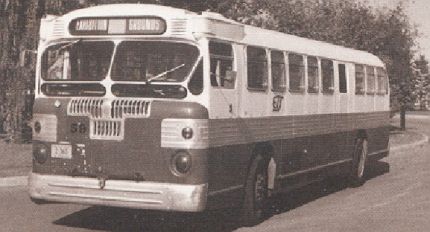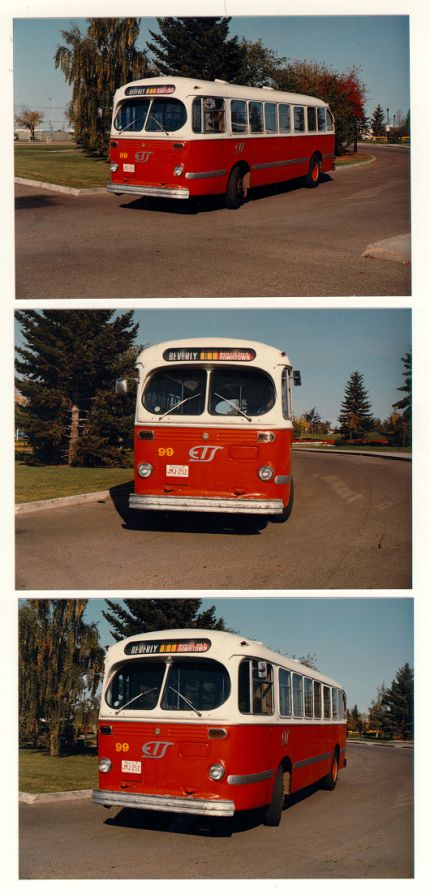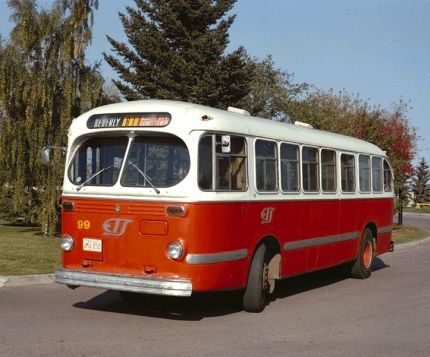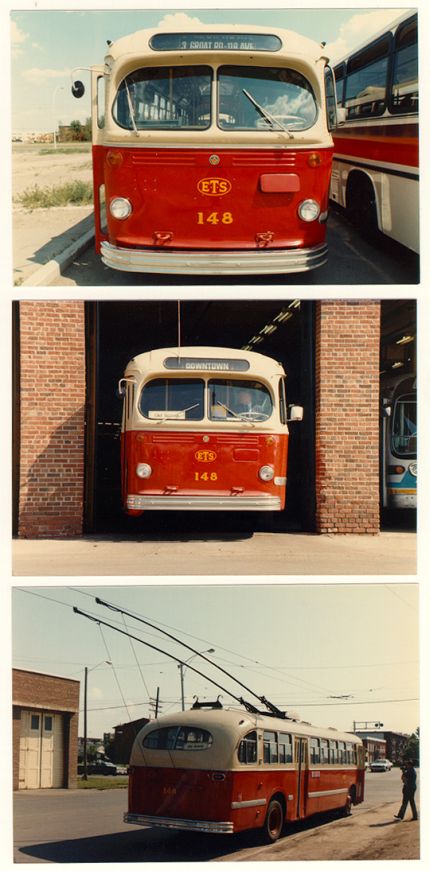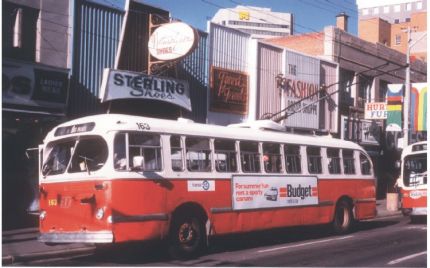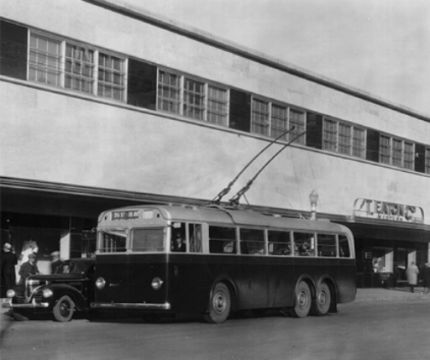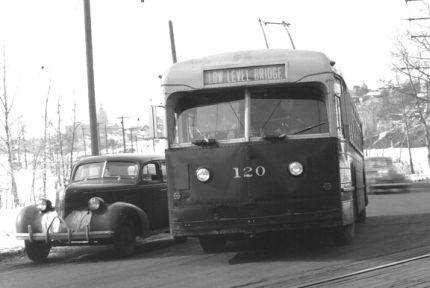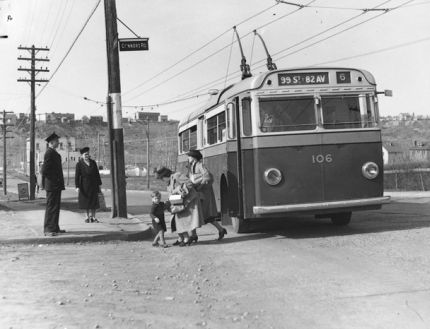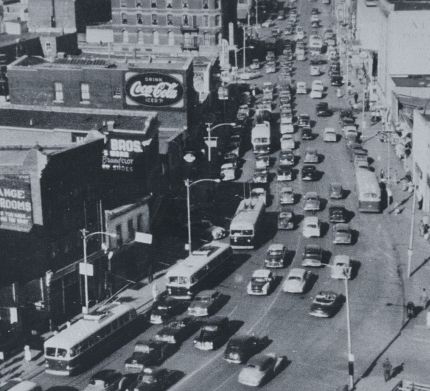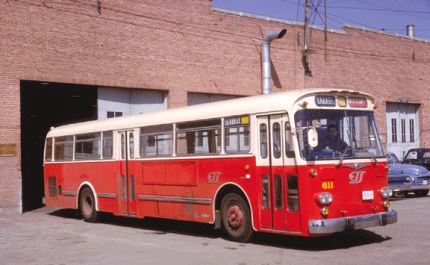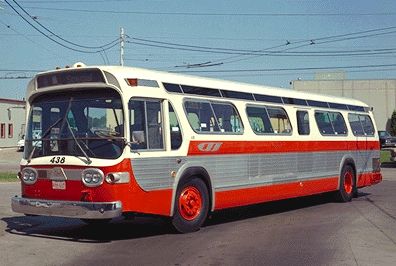1908
With a modest fleet of 4 streetcars, the Edmonton Radial Railway Service was established to meet the growing transportation demands of Edmonton's nearly 19,000 people. A ride on the first public streetcar system in the prairies would've set you back a nickel. The cars were made by the Ottawa Car Company Ltd. , and were built to accommodate double-ended operation, which means they never had to turn around on the 21 kilometre track.
1909
Money-saving transfers were introduced when passengers on the system were required to pay up to 3 times to travel from one end of the city to another. A new look for the streetcars saw trams painted green below the windowsills, and red above.
1910
During Exhibition Week, ridership on the system was 50,634 passengers.
1911
Daily ridership levels were at 4,784 passengers, which totalled $1,270 in fares. Tram Operator wages ranged from 25 to 30 cents per hour.
1912
Forty-seven new cars were added to the system as Edmonton's population reached nearly 60,000. There were 10,307,422 passengers throughout this year, and ETS records show a total of 1,203,260 streetcar miles.
1913
Streetcars began travel over the newly completed High Level Bridge.
1919
As more and more veterans returned home from the First World War, ridership began to increase. During Exhibition Week, 334,624 passengers were carried, up 56,140 from the previous year.
1932
The first permanent motor bus route is up and running on January 25, 1932 after the streetcar tracks showed signs of deterioration due to higher levels of motor traffic. The streetcars were also nearing retirement age, some at the million-mile mark.
1935
Ridership levels increased to 13. 2 million a year, and Edmonton had the lowest street railway fares in North America. The average was over 6 cents, and ETS fares were a deal at a nickel.
1939
Trolley bus service started in Edmonton on September 24, 1939. Trolley buses eventually took over the bulk of ETS, as streetcars were phased out in the years to come.
1943
Each trolley bus purchased this year cost $21,000.
1951
September first marked the last streetcar trip from 97 Street and Jasper Avenue across the High Level. That trip hosted a special delegation, including Edmonton's Mayor Parsons, to commemorate the end of a transit era.
1962
The City of Edmonton commissioned Canadian Bechtel Ltd. to develop a rapid transit system that would serve the city into the 1980s and beyond. Edmonton Transit introduced ‘rush hour express' routes and purchased more buses. ‘Bus Only' lanes went into service, and the monthly bus pass was introduced.
1974
Edmonton became the first city with a population under one million in North America to have a Light Rail Transit (LRT) system. It was the third city in Canada to incorporate LRT into its transit system. Construction for the LRT began at 95 Street and 106 Avenue for the new 7.2 kilometre line with a budget of $65 million.
1975
The Disabled Adult Transit System (DATS) was introduced on April 28 of this year. This innovative program was designed jointly by the City of Edmonton and the DATS Advisory Council to provide Edmonton's disabled adults greater independence and freedom.
1976
The ETS image was slightly altered when ‘System' was dropped from use, and a new logo and colour scheme were added. On Dec. 5, old alpha/numeric route designations were replaced with numbers only.
1977
ETS began testing its new LRT line.
1978
A milestone year for ETS! April 22 marked the opening of the LRT system in conjunction with the Commonwealth Games, which were held in Edmonton. The line ran along the CN right-of-way from Belvedere to the Coliseum and Stadium Stations, then to the Churchill and Central Stations.
1980
The Edmonton Radial Railway Society was formed. This not-for-profit group aims to restore and operate former Edmonton streetcars.
1981
A 2.2 kilometre LRT extension opened on April 26. This extension cost $10 million, and included Beverly in the LRT communities. ETS purchased 100 BBC trolley buses.
1983
ETS included accessibility features, such as elevators, in its new Bay and Corona LRT Stations, west of Jasper Avenue. This most-recent extension made the line a total of 9.9 kilometres.
1987
As of Jan. 1, DATS operations staff officially became City of Edmonton employees. This resulted from a brokerage system demonstration project operated in conjunction with the City of Edmonton, Transport Canada, and Grimble Consulting.
1989
Government Centre Station opened near Alberta's Legislature.
1992
The LRT moves south! At 23 metres below the surface, the University LRT Station and Transit Centre was the deepest in Edmonton's LRT system. Builders needed to match grade with the Dudley B. Menzies LRT Bridge, which is used exclusively for the LRT on the top level, and for pedestrians and cyclists on the lower. With this new extension, the LRT system grew to 12.3 kilometres in length, with six underground, and four surface stations.
1993
Edmonton Transit purchased 43 New Flyer Industries low-floor buses. The buses were manufactured in Winnipeg, Man., and provided important accessibility features. The buses did not have stairs at the front or rear doors, which made boarding and exiting easier. A kneeling feature, a hydraulically operated ramp, and two wheelchair positions were included in the $220,000 buses.
1994
Another 16 low-floor buses were added to ETS' service circulation. The Edmonton Transit System Advisory Board (ETSAB) was established. Edmonton Transit introduced ‘ExpressLink,' the super express route from Kaskitayo Transit Centre to the downtown for peak-hour commuters.
BusLink, an automated telephone service that provides route and schedule information, is offered to Mill Woods residents. The remaining Edmonton neighbourhoods had access to BusLink by the summer of 1995.
The first ‘Ride Free' day is offered by ETS on Remembrance Day. Similar promotions followed annually.
The first annual Christmas Light Tour was introduced to Edmontonians, and toured through Candy Cane Lane, and the Provincial Legislature lights. The free-of-charge promotion's success resulted in plans for expansion in the years to come.
1995
April of this year saw BusLink offered to every Edmonton resident.
Edmonton Transit information is made available through the Edmonton FreeNet, and a local Bulletin Board Service (BBS).
Student stickers on school ID cards were tested.
Mobility Choices, a customer-oriented program, was introduced by ETS. This community award winning program details a variety of accessible travel options offered by ETS, and informs customers on how to use them.
Vinyl wrapped buses were introduced.
A pilot project to test accessible ramps on LRT cars begins.
1996
Edmonton Transit's Horizon 2000 service plan was set in motion. The plan called for overall service restructuring, including a basic network of routes supplemented by flexible community routes. The project, based on local public input, was to be implemented in June of 1997.
Transit information is made available via the Internet in January.
A new sculpture, ‘Ridden Down' by Alberta artist Clay Ellis, was installed in the Churchill LRT Station.
Edmonton Transit began testing bike racks on all Route 9 buses.
Stop Request program hours were extended.
The Donate-a-Ride program commences over the Christmas and New Year's holidays.
1997
The new Commendations and Concerns Telephone Information System (CACTIS) was implemented in late March.
Members of the Edmonton Radial Railway Society begin operating the High Level Bridge Streetcar in the summer months.
The public learns of upcoming changes to the transit system through a comprehensive public outreach program.
Three free days follow the kick off of the new network of transit routes throughout Edmonton.
1998
ETS transfers got a new look this year.
DATS changes its name from Disabled Adult Transportation System to Disabled Adult Transit Service.
The new Belvedere LRT Station opened in August.
ETS purchased 80 new low-floor buses in August.
1999
New features were added to BusLink. Transit users could now obtain low-floor bus, accessible service, and bike rack information from the convenient automated service.
A commemorative mural celebrating 20 years of LRT service to the community was unveiled in the Central LRT Station.
This mural by artist Mariann Sinkovics celebrates 20 years of Light Rail Transit (LRT) service to the citizens of Edmonton. The history of the LRT system contains a number of significant milestones in both its construction and service to its customers.
Edmonton was the first city in North America with a population under 1 million to build a Light Rail Transit System. The first segment of the LRT opened in April 1978, just prior to the Commonwealth Games. One of the major challenges for the system was to engineer and build 1.6 km of track under the downtown business centre of Edmonton. Other major challenges included tunnelling through the complex geological conditions which make up Edmonton's river valley and constructing Government Centre Station using inclined piles to save the 50 year old trees lining the boulevard. Construction of the Edmonton system contained a number of ‘firsts' including the first use of the hydroshield tunnel boring machine in North America, the first use of the sequential excavation method of tunnelling in soft ground in North America and construction of the first segmental post-tensioned bridge in Western Canada. At the time of construction the Dudley B. Menzies Bridge contained the longest spans for a segmental post-tensioned bridge in North America.
Edmontonians and visitors have taken the LRT to most of Edmonton's major events in the past 20 years starting with the Commonwealth Games in 1978. Edmonton has hosted the World University Games - Universiade ‘83; major concerts by artists such as David Bowie, the Rolling Stones, Pink Floyd; sporting events ranging from Stanley Cup finals, Grey Cups, 1996 World Figure Skating Championships, World Cup Soccer Qualifying Events to Canadian Finals Rodeos; festivals such as Edmonton's Klondike Days, The Works, Jazz City and the Street Performers Festival. LRT also serves daily activities such as work, school and shopping.
ETS hosted its first Community Conference in mid-May.
ETS celebrates 60 years of trolley service to Edmontonians.
To recognize Wayne Gretzky for his contributions to Edmonton, ETS renumbered Route 89 to Route 99.
ETS hosted the annual Canadian Urban Transit Association (CUTA) conference in November.
ETS purchased 49 new low-floor buses.
2001
Pattison Outdoor Group was awarded a 10-year ETS advertising contract that included vehicles, benches, and shelters.
The ETS website got a new look and feel in conjunction with the City of Edmonton's virtual redevelopment.
ETS' Customer Services Centre in the Churchill LRT Station is renovated to improve our ability to serve you better.
ETS got a little green in the St. Patrick's Day Parade.
As part of a partnership with Telus, ETS installed public TTY payphones in all LRT stations.
DATS celebrated its 25th anniversary in April.
ETS hosted its second Community Conference in early May.
A new Heritage Transit Centre replaced the existing one.
ETS opened its third Mill Woods location, the Mill Woods Transit Centre.
Captain COWmute, the ETS entry in the "Cows in the City" promotion, was introduced to Edmonton.
2001
A new ETS website is launched.
The new Clareview LRT Station went into service in March, and was officially opened in September.
ETS received 66 new low-floor buses, and six articulated buses.
May brought ETS' annual Community Conference.
Edmonton hosted the 2001 World Championships in Athletics for 10 days in the summer, and ETS staff was busy providing transit service for international guests to the city.
Construction on the Kingsway and Castle Downs Transit Centres began in September.
The BusLink menu changed in September.
A new Donate-a-Ride website is launched in December.
2002
The Canadian Urban Transit Association (CUTA) launches its National Awareness Program in January.
Upgrades to the Kingsway and Castle Downs Transit Centres are completed in February.
ETS' fourth annual Community Conference was held in May.
August brought the unveiling of ETS' first graffiti art mural in the LRT system.
The Bikes on Buses program was expanded to Routes 1 and 4 in September.
Fifty-three new low-floor buses were added to the ETS fleet.
ETS provided service for the 2002 Grey Cup in late-November.
2003
Edmonton's LRT system celebrated 25 years of service on April 22.
A new monthly pass for seniors was implemented.
ETS introduced a new home page on takeets.com.
The fifth Community Conference was hosted by ETS in May.
New priority seating decals were installed at the front of each bus.
ETS added 50 new low-floor buses and seven articulated buses to the fleet.
2004
New ETS transfers were introduced in February. The transfer now tells you when it expires. The time the transfer expires is now the time where it is torn.
The sixth annual Community Conference was hosted by ETS in March.
Route Schedule Search is available on the ETS website in the spring.
ETS launched new Trip Planner on June 21, 2004. Bus Stop Schedule Search is also launched.
Centre Free LRT is cancelled.
Extra ETS service provided on Friday, October 8 for Edmonton's Centennial celebrations.
2005
In January, the address and intersection look-up feature was added to the online tools to make it easier to find Find your Bus Stop #.
The seventh annual Community Conference was hosted by ETS in March.
A new, improved version of the Mobility Card for persons with disabilities was introduced.
In April, new fare vending machines went into service in the LRT Stations.
ETS introduced BOB, a new initiative focusing on bus behaviour and etiquette.
ETS provided some special service in support of the Royal Visit in May.
ETS played a major role in providing an extensive Park & Ride service to the Grand Prix.
Lots of new service was added in September, thanks to an increase in the ETS budget for 2005.
A subsidized monthly transit pass for AISH recipients living in Edmonton is now available under a regular, ongoing program.
ETS provided special service for Provincial Centennial celebrations in September.
The Disabled Adult Transit Service (DATS) introduced a new service model for its customers.
ETS begins operating a commuter service to Fort Saskatchewan and Edmonton Garrison.
Effective October 2005, the subsidized transit pass for AISH recipients becomes an ongoing program after an overwhelmingly positive response among participants.
2006
The new Health Sciences LRT Station opened on January 3 making the track 12.9 kilometres in length.
The eighth annual Community Conference was hosted by ETS in March.
New School Services online tool on the web launched on August 2nd.
BusLink hit a new record on September 5th, when the system handled 15,224 calls. That's an average of 1 call every 5 to 6 seconds over the 24-hour period.
2007
A mapping feature was added to the Trip Planner in March.
New look for takeETS.com launched, highlighting the Online Trip Tools.
2008
Edmonton Transit celebrates 100 years of service.
ETS Transit operator Rod was named Outstanding Driver in Edmonton Tourism's Annual You're Welcome Edmonton Awards.
New look for ETS website and Online Trip Tools launched in September. DATS implemented a new computer system with automated scheduling.
The City of Edmonton introduces 311. 311 allows citizens to access information on city programs and services – including transit information such as trip information, schedules, fares, special event information.
2009
Edmonton Transit introduces the ETS Street Team and a prototype vehicle called ETS Platinum.
ETS Bay LRT station is re-named to Bay/Enterprise Square.
ETS Health Sciences LRT station is re-named Health Sciences/Jubilee.
New LRT stations opened in April at South Campus, McKernan/Belgravia, and Leger.
City Council voted on April 28, 2009 to move forward the decommissioning of the trolley operations in Edmonton as one of the cost saving measures due to a city-wide budget deficit. The last day of trolley bus operations was May 2, 2009.
2010
ETS celebrated a fully accessible transit fleet and said farewell to our long-serving GMC buses.
Centennial Garage was officially opened on April 10.
LRT service to Southgate and Century Park began on April 26.
Meadows Transit Centre became operational on April 26. The official opening ceremony was held on September 2.
DATS celebrated 35 years of service to the citizens of Edmonton on April 28.
2011
The ETS Text Messaging service was launched, allowing patrons to receive schedule information through texts.
Two new transit centres opened - the Eaux Claires TC at 97 Street and 157 Avenue and the Lewis Farms TC at 87 Avenue, west of Anthony Henday Drive.
The book, Ride of the Century, The Story of the Edmonton Transit System, was released in Fall of 2011 and topped Edmonton's Top 10 Non-Fiction Bestseller list.
The ETS Trip Planner was launched with all of the trip planning tools now in one convenient location.
The Paid Park & Ride project started at Clareview, Belvedere, Stadium and Century Park LRT parking lots.
The Smart Bus initiative was approved by City Council. ETS was tasked with collecting Smart Bus requirements and releasing a tender based on those business requirements to select a solution to meet the needs of Edmonton Transit.
The ETS Facebook page launched, allowing customers a new way to find out about ETS news, events and contests.
2012
Route 747 with direct service to the Edmonton International Airport was launched.
ETS To Go, the mobile website version of the ETS Trip Planner, became available for use on all mobile devices.
The Transit Bylaw was updated to reflect the changes in policy and technology since it was originally brought into effect. This included raising the fines for fare evasion.
Central LRT Station roof structure underwent repairs to reinforce it structurally and to add waterproofing.
The Northgate Transit Centre upgrades began in 2012 with the construction of a new shelter.
Aboriginal art panels were added along South LRT line.
After evaluating proposals from various vendors, the Trapeze Group was awarded the Smart Bus contract.
2013
The LRT lines were officially named - Capital Line, Metro Line, Energy Line, Valley Line and Festival Line.
The first Smart Bus enabled routes began operating in July on Route 111 and 128, going live with automated stop announcement and mobile data terminals feeding data directly to the ETS Control Centre. Departure boards and the ETS Live real-time tools launched in September and October respectively.
ETS celebrated the 20th anniversary of low floor accessible buses in Edmonton.
ETS celebrated the 35 year anniversary of the LRT, now providing service from Clareview to Century Park and thirteen other LRT stations.
ETS Customer Service Centre moved out of the Churchill pedway and into City Hall.
Pattison OneStop digital television network was added to LRT stations, allowing patrons access to up to date announcements about working escalators and elevators, weather and news.
South Campus Station was renamed South Campus/Fort Edmonton Park Station. As well, the Route 595 was added to provide service between South Campus/Fort Edmonton Park Station and Fort Edmonton Park.
The warning tile replacement program was completed in all LRT stations.
2014
On the Capital Line, between Stadium and Churchill stations, the LRT carries more than 15,000 passengers on weekdays.
For the Capital Line, between McKernan/Belgravia and Health Sciences stations, the most heavily travelled section, the LRT carries more than 22,000 passengers.
2015
The Metro Line LRT from Churchill downtown station to Grant MacEwan and to NAIT starts up. Expected ridership is 13,200.
2016
All regular ETS buses are equipped with Smart Bus technology and are providing real-time information to customers and ETS control.
Valley Line begins Construction on the first phase of the Valley Line LRT, from downtown to Mill Woods, began in the spring.
2017
Edmonton Transit System (ETS) publicly announces its new name, Edmonton Transit Service.
2018
Light Rail Transit (LRT) celebrated 40 years of service to the citizens of Edmonton on April 22.
2023
In 2023, Donate-A-Ride underwent a name change and became the Transit Access Grant (TAG) program.


